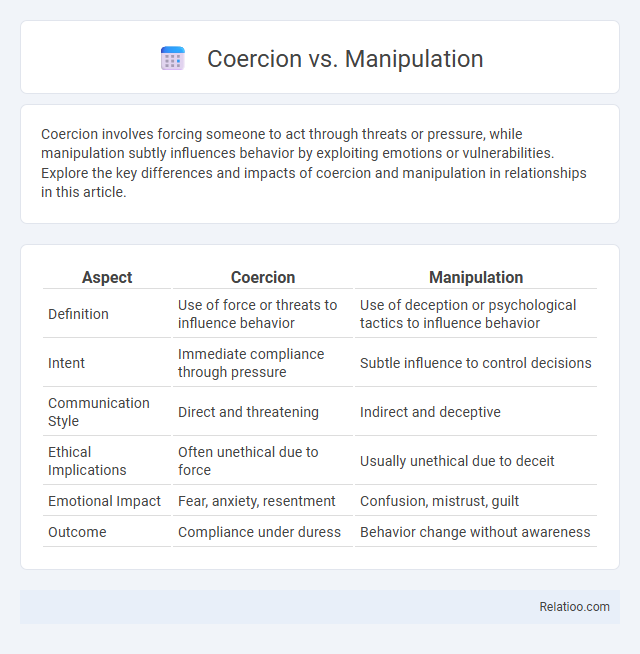Coercion involves forcing someone to act through threats or pressure, while manipulation subtly influences behavior by exploiting emotions or vulnerabilities. Explore the key differences and impacts of coercion and manipulation in relationships in this article.
Table of Comparison
| Aspect | Coercion | Manipulation |
|---|---|---|
| Definition | Use of force or threats to influence behavior | Use of deception or psychological tactics to influence behavior |
| Intent | Immediate compliance through pressure | Subtle influence to control decisions |
| Communication Style | Direct and threatening | Indirect and deceptive |
| Ethical Implications | Often unethical due to force | Usually unethical due to deceit |
| Emotional Impact | Fear, anxiety, resentment | Confusion, mistrust, guilt |
| Outcome | Compliance under duress | Behavior change without awareness |
Understanding Coercion: Definition and Characteristics
Understanding coercion involves recognizing it as a form of pressure where force or threats are used to compel someone to act against their will, often stripping away genuine consent. Coercion is characterized by an imbalance of power, lack of voluntary agreement, and the presence of fear or intimidation as driving factors. Your awareness of these defining traits helps in distinguishing coercion from subtle manipulation or influence tactics.
What Is Manipulation? Key Traits and Examples
Manipulation involves influencing others through deceptive, exploitative, or covert tactics to achieve personal gain, often at the expense of the target's autonomy. Key traits of manipulation include psychological exploitation, emotional deception, and strategic use of misinformation to control decisions and behaviors. Examples of manipulation include gaslighting in relationships, misleading advertising, and exploiting trust within professional environments to secure advantages.
Coercion vs Manipulation: Core Differences Explained
Coercion involves using force or threats to compel someone to act against their will, whereas manipulation relies on psychological tactics to influence someone's decisions subtly. The core difference lies in coercion's explicit pressure and potential harm, while manipulation often exploits trust and emotions to achieve control. Understanding these distinctions helps you recognize and respond effectively to each behavior in interpersonal dynamics.
Psychological Mechanisms Behind Coercion
Coercion operates through psychological mechanisms such as fear, threat, and intimidation to compel compliance, overriding Your free will. Unlike manipulation, which subtly influences through persuasion or deception, coercion relies on direct pressure or punishment to control behavior. Understanding these mechanisms helps identify when psychological boundaries are being violated in interpersonal dynamics.
Subtle Tactics: The Art of Manipulation
Subtle tactics in manipulation revolve around influencing others through nuanced psychological strategies such as gaslighting, guilt-tripping, and emotional exploitation, which often bypass conscious awareness. Unlike coercion's overt force or threats, manipulation leverages ambiguity and trust to control decisions and behaviors discreetly. Mastering these subtle manipulation techniques involves understanding cognitive biases, social dynamics, and emotional vulnerabilities to subtly steer outcomes without direct confrontation.
Motivations: Why Do People Coerce or Manipulate?
People coerce or manipulate others primarily to gain control, achieve personal goals, or secure power in relationships or situations. Motivations often stem from desires for dominance, self-benefit, or to influence outcomes without consent. Understanding these drives reveals the psychological and social dynamics behind coercion and manipulation tactics.
Ethical Implications of Coercion and Manipulation
Coercion involves forcing someone to act through threats or pressure, raising significant ethical concerns due to the violation of personal autonomy and consent. Manipulation subtly influences behavior by exploiting emotions or cognitive biases, often leading to ethical dilemmas related to deception and undermining trust. Your awareness of these distinctions is crucial for evaluating the moral implications in interpersonal and organizational contexts.
Recognizing Coercive and Manipulative Behaviors
Coercion involves using threats or force to control someone's actions, while manipulation subtly influences emotions or perceptions to achieve desired outcomes without overt pressure. Recognizing coercive behaviors requires identifying intimidation, threats, or physical force, whereas manipulative actions often present as guilt-tripping, gaslighting, or distortion of facts. Awareness of these distinctions is crucial for safeguarding personal boundaries and maintaining psychological well-being.
Real-Life Scenarios: Coercion and Manipulation Compared
Coercion involves forcing someone to act against their will through threats or intimidation, often seen in situations like workplace bullying or abusive relationships. Manipulation subtly influences others by exploiting emotions or cognitive biases, such as a colleague twisting facts to gain favor or control. Both tactics impact decision-making and autonomy, but coercion relies on overt pressure while manipulation uses psychological influence to achieve compliance.
Strategies for Defending Against Coercion and Manipulation
Defending against coercion and manipulation requires recognizing their distinct tactics: coercion uses threats or force to control, while manipulation relies on subtle influence and deception. Strengthening your emotional intelligence and setting clear boundaries empower you to identify and resist these harmful strategies. Cultivating assertiveness and seeking support from trusted sources enhance your ability to maintain autonomy and protect your well-being.

Infographic: Coercion vs Manipulation
 relatioo.com
relatioo.com